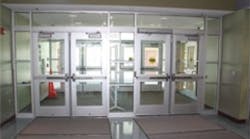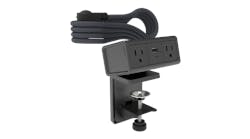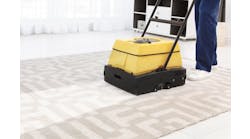Many mattress manufacturers recommend that consumers rotate their mattresses at least twice a year to help prevent soft spots from developing and increase the product’s life span. In fact, one manufacturer believes rotating mattresses is so important that it even suggests doing so when people change your clocks twice a year for Daylight Saving Time. Its slogan: Spin the mattress around in spring; flip it over in fall.
It’s unfortunate that the same kind of treatment can’t be applied to flooring for schools, such as carpeting, especially in hallways. Being able to flip or turn a carpet might delay or prevent what commonly is referred to as traffic-lane soiling, an unsightly problem that often afflicts carpeting in public facilities. This is when carpeting becomes dark and soiled, usually in the center of a major walkway, and especially when compared with its outer edges. In fact, it is not uncommon for the outer edges of carpeting in heavily trafficked areas to look virtually brand-new, while the center area may be dark, grimy, worn, spotted and even torn.
Cleaning Measures
Why does this happen to flooring for schools? The cause is simple. Soils, spills, "gray" moisture found on shoes, grease, dust, dirt, sand and other contaminants are tracked in over a carpet’s center traffic lane and essentially are pounded into the fibers by foot traffic. Although carpeting is designed to trap and hide soiling, it does eventually reach a saturation point, at which point darkening and other telltale signs of damage begin to appear.
In some cases, cleaning professionals may use spotters and stain removers to clean and repair these darkened areas. However, in most cases, the carpeting areas that tend to be affected by traffic-lane soiling are far too large to be cleaned effectively with spotters or removers; such issues generally require more extensive treatment options.
Cleaning professionals also may try to clean carpeting affected by traffic-lane soiling using carpet shampooers or the bonnet cleaning method. These interim cleaning methods can remove surface soils and provide temporary cleaning benefits, but often they have two key drawbacks:
•Although these systems can remove some of the soiling, they often simply spread the soil over more of the carpet.
•Just as damaging, these cleaning methods can leave a chemical residue in the carpet, resulting in what is known as resoiling. This is when chemical residue left in a carpet acts as a magnet for other contaminants, drawing soils into the carpet and making the traffic lane even darker and more unsightly. Resoiling also can be an issue when spotters are used.
Thankfully, there are effective ways to help prevent traffic-lane soiling and remove it if it develops. Incorporating specific strategies to flooring for schools can keep hallway and other walkway carpets looking their best for longer, which can delay expensive carpet replacements.
What’s on Our Shoes?
Although spills—including juice, soft drinks, ink and food—are common causes of traffic-lane soiling, the key culprits usually are the contaminants found on the bottom of shoes. Studies conducted by ISSA, the worldwide cleaning association, have found the typical building acquires 24 pounds of dirt through key entries during a 20-day work period. An estimated 85 percent of all soil in a facility enters on people’s shoes. This soiling can accumulate even faster in especially busy locations. As dirt is walked into a facility, much of it ends up on carpet traffic lanes.
What’s more, there is far more than just "dirt" being tracked onto carpeting.
A few years ago, Dr. Charles Gerba, a microbiologist with the University of Arizona, asked 10 people to wear new pairs of shoes for two weeks. During this period, participants went about their normal routine—going to classes, walking through parking lots, going in and out of stores and shopping malls. At the end of the two weeks, the shoes were returned, and the contaminants on their bottoms were analyzed. The results:
•More than 400,000 units of bacteria were present on the shoes.
•Coliform, a broad-class bacterium found in the feces of humans and other warm-blooded animals, was found on virtually all of the shoes.
•E. coli was reported on about one-third of the shoes.
•Gray moisture, food, sand, grease, oil, tar, clay and dust were found in varying degrees on all the shoes.
Although carpet fibers can hide and contain most of these contaminants, soiling inevitably builds up even in the highest-quality carpeting. Once the carpet reaches its saturation point, the situation not only contributes to traffic-lane soiling, but also can become a health hazard.
A Systems Approach to Prevention
There really is only one way to prevent or reduce traffic-lane soiling: an effective matting system. The word "system" is key. When indoor and outdoor mats are simply placed randomly at main entryways, their effectiveness at capturing outdoor contaminants can be minimal.
Instead, use a system called "The Rule of 15." This starts with 5 feet of scraper matting placed outside a building entry. Scraper matting, as the name implies, scrapes off larger particulates and soils from the bottoms of shoes.
Next, 5 feet of scraper/wiper matting should be placed adjacent to doors within the vestibule area or a building’s double-door entry area. In addition to removing remaining larger soils, this matting also collects and traps moisture from shoe bottoms. Advanced scraper/wiper matting systems are manufactured with bi-level construction, which enables moisture and soils to seep beneath the surface of the matting so that they cannot re-adhere to shoes.
The final 5 feet of matting is called wiper matting and is placed inside the facility. Often called "The final line of defense," wiper matting is designed to capture any remaining soil and moisture and prevent them from entering the facility.
Deep Cleaning
Interim carpet cleaning methods, including shampooing and bonnet cleaning, have their limitations when it comes to removing traffic-lane soiling. They may spread soils and cause resoiling, and are not designed to reach into carpet fibers to remove deeply embedded contaminants. To do this, a carpet extractor—particularly a hot-water machine—is required.
What steps need to be taken to thoroughly treat traffic-lane soiling via hot-water extraction?
First, vacuum the traffic lane area and all other carpeted areas that will be cleaned. This step, which often is overlooked, removes surface-level dust and dirt and helps the extractor work more effectively.
If spots and stains are present, determine what types of material they are and then remove them with the proper spotter. Be sure to test an inconspicuous area of the carpet for colorfastness first.
Apply a prespray to the traffic lane—this typically is done with a pressure sprayer. Allow the chemical to dwell on the carpet for a few minutes per manufacturer’s instructions. Excessive soiling may require the area to be raked prior to cleaning; this agitation loosens soils and ensures that the chemical is spread evenly throughout the carpet.
The final step involves using an extractor with a carpet wand attachment. The forward movement of these machines applies water to the carpets, while the backward movement removes the moisture along with the prespray solution and the soils that are causing traffic-lane soiling.
Be sure to select a model that heats the solution to more than 200°F at the wand tip, which improves the effectiveness of the machine. Studies dating back over 100 years have proven that the chemical action of cleaning chemicals is increased by a factor of two for every 18 degrees of temperature above 118°F.
Using heat to clean can be effective even without chemicals. According to Dr. Michael Berry, author of Protecting the Built Environment: Cleaning for Health, "Even without soap, small amounts of grease will dissolve in water, [but] the amount increases in hot water, sometimes tenfold."
Another simple, yet very effective step maintenance personnel can take in order to avoid or delay traffic-lane soiling: regular vacuuming. Beyond improving the immediate appearance of carpeting, vacuuming actually can be seen as a kind of soiling-management procedure. If performed on a regular basis, vacuuming removes a great deal of dry contamination before it can become embedded in carpet fibers, preventing it from spreading to other areas of the carpet.
Baxter is a product engineer for U.S. Products, Mukilteo, Wash., manufacturers of hot-water extractors and other tools and equipment designed for the professional carpet cleaning industry. He can be reached at [email protected].



